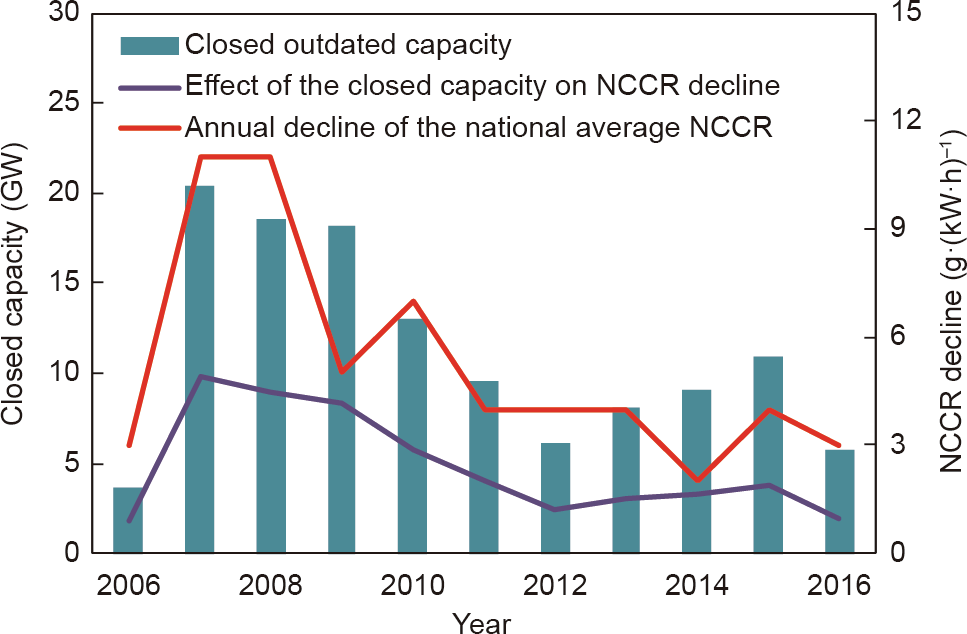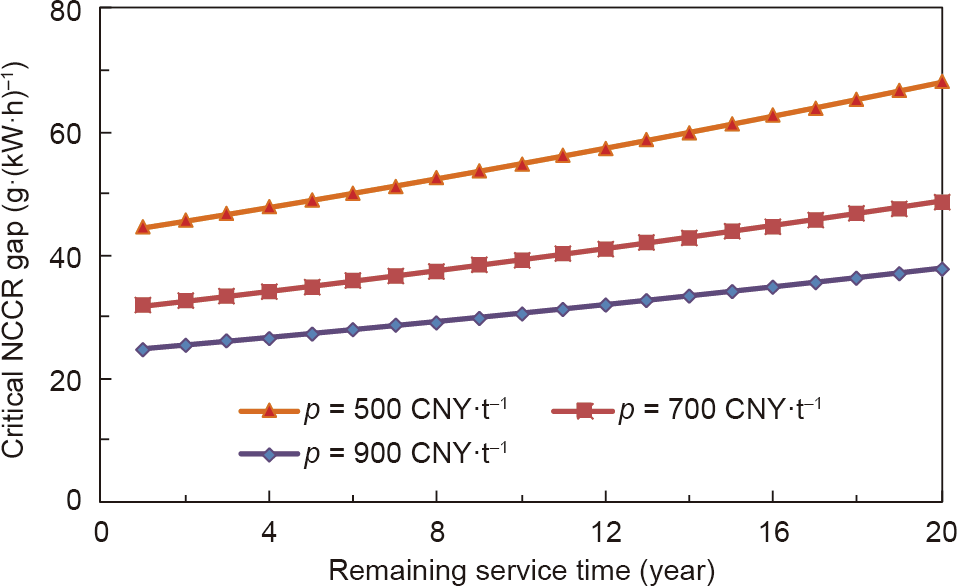《1. Introduction》
1. Introduction
As China’s main power source, the coal-fired power industry has supplied about 80% of electricity in China over the past several decades↑ , while consuming roughly half of the coal generated in China [1]. Given China’s resources endowment [2], it will be difficult to change the dominant status of coal in China’s primary energy structure in the near future [3]. Therefore, saving energy in the coal-fired power industry is vital to China’s energy supply and energy security. On a basic level, advanced technology is the driving force for energy conservation. However, for the entire coal-fired power industry of a state, upgrading the installed power unit structure may play a more important role. Eliminating outdated capacity is a significant part of upgrading a state’s installed power unit structure. However, eliminating outdated capacity is hard to be carried out considering the economic benefit of power companies in China. Continual organized action to eliminate outdated coal-fired power capacity is required in order to solve the problems of energy saving, energy supply, and energy security.
↑ Calculated from the data of the National Power Industry Statistics Bulletins from 1950 to 2018.
《2. A brief history of the elimination of outdated capacity》
2. A brief history of the elimination of outdated capacity
In the coal-fired power industry, the phrase ‘‘outdated capacity” normally refers to relatively small thermal power units. In past decades, outdated coal-fired power capacity included units with capacities below 0.1 MW (prior to 1949), 0.5 MW (1949–1960s), 25 MW (1970s), 50 MW (1980–1997) [4], 100 MW (1997–2007) [5], and 200 MW (2007 and forward) [6]. The former China State Power Corporation was the first to initiate organized action to close down outdated capacity in 1997. By installing large units to replace small units, units of about 2.8 GW with a nominal capacity below 50 MW were closed down before 1998. Then, when the Suggestions on the Shutdown of Small Thermal Power Units report [7] was issued in 1999, the first nationwide organized action to eliminate outdated capacity was implemented [8]. Table 1 lists statistical data on the elimination of outdated capacity in the coalfired power industry since 1996. It can be seen from the table that outdated units of about 10.11 GW were closed prior to 2000. However, due to a nationwide power shortage that occurred in 2003, this nationwide organized action was suspended. During the period of the 10th Five-Year Plan (2001–2005), the closed capacity of outdated coal-fired power units reached approximately 8.30 GW, which only accounted for 55% of the planned eliminated capacity (Table 1).
As the power shortage was resolved, the interrupted action to eliminate outdated capacity resumed at the end of 2005. Afterward, a new nationwide program to eliminate outdated coal-fired power capacity was launched in 2007. During the period of the 11th Five-Year Plan (2006–2010), the eliminated capacity of outdated coal-fired power units reached 76.83 GW, which was 54% greater than the planned eliminated capacity. During the period of the 12th Five-Year Plan (2011–2015), another 43.72 GW of outdated coal-fired power units was eliminated, which was more than double the planned eliminated capacity, as shown in Table 1.
《Table 1》
Table 1 Data on the elimination of outdated capacity since 1996.

《3. Effect of eliminating outdated capacity on energy conservation》
3. Effect of eliminating outdated capacity on energy conservation
To evaluate the overall efficiency of a unit, the net coal consumption rate (NCCR, g·(kW·h)-1 ) is widely adopted by the coalfired power industry. The NCCR normally refers to the mass of consumed standard coal per unit of power generated. The nominal capacities of most of the units that have been closed during the last decade are in the range of 6–100 MW, and the average operating NCCR of these units has been estimated as 490 g(kW·h)-1 . Based on the data on annual closed capacity, the national average NCCR, and the national installed coal-fired power capacity, the effect of eliminating outdated capacity on the annual decline of the national average NCCR was calculated. Fig. 1 portrays the closed outdated coal-fired power capacity, its effect on the decline of the national average NCCR, and the total decline of the national average NCCR.
《Fig. 1》

Fig. 1. The effect of eliminating outdated capacity during 2006–2016.
It can be seen from Fig. 1 that eliminating outdated capacity has had a great impact on the decline of the national average NCCR. During 2007–2009, the annual average closed outdated capacity was as high as approximately 19 GW; as a result, the national average NCCR was reduced by approximately 4.5 g(kW·h)-1 annually. As the action to eliminate outdated capacity gradually became normalized, its effect on the annual decline of the national average NCCR decreased to a stable level of about 2 g(kW·h)-1 .
On the whole, the decreasing trend of the national average NCCR is consistent with the trend of eliminating outdated capacity, which implies a close inherent connection. During the periods of the 11th and 12th Five-Year Plans, the overall effect of eliminating outdated capacity on the decline of the national average NCCR reached approximately 27 g(kW·h)-1 , which accounted for about 46% of the corresponding total decline of the national average NCCR.
According to incomplete statistics on the coal-fired power industry that were collected at the end of 2016 by the China Electricity Council, there are 5198 coal-fired power units with nominal capacities of N < 100 MW and installed capacities of about 92 GW; 471 with nominal capacities of 100 MW ≤ N < 200 MW and installed capacities of about 65 GW; 251 with nominal capacities of 200 MW ≤ N < 300 MW and installed capacities of about 54 GW; and 1090 with nominal capacities of 300 MW ≤ N < 600 MW and installed capacities of 360 GW in China. By treating these units as outdated capacity, and by assuming the average operating NCCRs of the units in these ranges to be 490, 380, 330, and 328 g(kW·h)-1 , respectively, the effects of eliminating these different ranges of units on the decline of the national average NCCR was calculated, and is shown in Fig. 2. It can be seen from Fig. 2 that if all of the coal-fired power units with nominal capacities in the ranges of below 100 MW, 100 MW ≤ N < 200 MW, 200 MW ≤ N < 300 MW, and 300 MW ≤ N < 600 MW are closed and replaced with the state-of-the-art double reheat 1000 MW ultrasupercritical units (with an NCCR of 276 g(kW·h)-1 ), the national average NCCR could be reduced by about 20, 7, 3, and 19 g(kW·h)-1 , respectively.
《Fig. 2》

Fig. 2. An estimation of the effects of eliminating different types of outdated coalfired power units.
《4. Evaluation of energy-related and economic benefits》
4. Evaluation of energy-related and economic benefits
As coal-fired power technology is continually being developed, the technical definition of outdated coal-fired power capacity should be updated accordingly, on the grounds that the reward from energy conservation is the main profit of this project, and that the initial financial investment (Fc, CNY·kW-1 ) is the main cost. By taking the life-cycle of an ordinary coal-fired power project as 30 years, an economically plausible criterion for replacing a coalfired power unit with a state-of-the-art one is expressed as inequality (1), where  represents the financial net present value of the reward from energy conservation, and n refers to the number of left on-service years. By denoting the unit price of standard coal as p (CNY·t-1 ), the annual utilization hours (AUHs) as m (h·a-1 ), the NCCR gap between the replaced unit and the state-of-the-art one as
represents the financial net present value of the reward from energy conservation, and n refers to the number of left on-service years. By denoting the unit price of standard coal as p (CNY·t-1 ), the annual utilization hours (AUHs) as m (h·a-1 ), the NCCR gap between the replaced unit and the state-of-the-art one as  (g·(kW·h)-1 ), and the capital rate of return as i (%), the
(g·(kW·h)-1 ), and the capital rate of return as i (%), the  can be calculated by Eq. (2) [9]. Inequality (1) and Eq. (2) can then be rearranged as inequality (3). The critical NCCR gap,
can be calculated by Eq. (2) [9]. Inequality (1) and Eq. (2) can then be rearranged as inequality (3). The critical NCCR gap,  for economically feasible elimination can then be expressed as Eq. (4).
for economically feasible elimination can then be expressed as Eq. (4).

By assuming that the initial financial investment is 3180 CNY·kW-1 [10], the AUH is 5000 h, and the capital rate of return is 5%, the correlation between the critical NCCR gap and the remaining service time was calculated and is exhibited in Fig. 3. As can be seen from this figure, given an average standard coal price of 700 CNY·t-1 , the critical NCCR gaps are estimated to be about 40 and 49 g·(kW·h)-1 for remaining service times of 10 and 20 years, respectively. However, these two critical values of the NCCR gap are estimated to be about 55 and 68 g·(kW·h)-1 at a standard coal price of 500 CNY·t-1 , and about 31 and 38 g·(kW·h)-1 at a standard coal price of 900 CNY·t-1 .
《Fig. 3》

Fig. 3. Variations in critical NCCR gap under different coal prices.
Considering a different AUH, and assuming the initial financial investment to be 3180 CNY [10], the capital rate of return to be 5%, and the unit price of standard coal to be 700 CNY·t-1 , the correlation between the critical NCCR gap and the remaining service time was calculated and is illustrated in Fig. 4. It can be seen from this figure that as the AUH decreases to 4000 or 3000 h·a-1 , the critical NCCR gaps are estimated at about 49 and 61 g·(kW·h)-1 , or 65 and 81 g·(kW·h)-1 , for remaining service times of 10 and 20 years, respectively. In regard to the peaking load units, the AUH could be even less, which would make the critical value of the NCCR gap even higher.
《Fig. 4》

Fig. 4. Variations in critical NCCR gap under different AUHs.
《5. Summary》
5. Summary
The elimination of outdated capacity, as an effective way of upgrading the national power unit structure, has contributed a great deal to China’s energy conservation. During the last decade, the elimination of outdated capacity has resulted in a decrease in the NCCR of about 27 g·(kW·h)-1 , which accounts for about 46% of the overall decline of the national average NCCR. Based on the pay-back rule, the elimination of outdated capacity is determined by the gap between the NCCR of the replaced unit and that of the state-of-the-art unit. This NCCR gap is subjected to the factors of initial financial investment, capital rate of return, AUH, unit price of standard coal, and remaining service time. For a typical case, where the AUH and standard coal price are assumed to be 5000 h·a-1 and 700 CNY·t-1 , respectively, if a unit simultaneously meets the conditions of having an NCCR gap greater than 40 g(kWh)1 and a remaining service time of less than 10 years, it is suggested that it be closed down. An added value of 15 g·(kW·h)-1 is required in the case of a low standard coal price (less than 500 CNY·t-1 ), and an added value of 25 g·(kW·h)-1 is required in the case of peaking load units (AUH less than 3000 h·a-1 ).














 京公网安备 11010502051620号
京公网安备 11010502051620号




